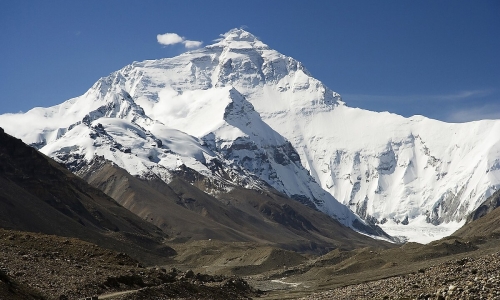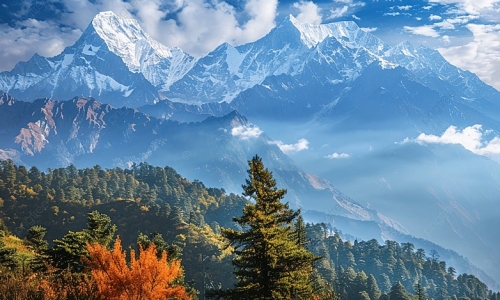The Differences Between Himalayan Buddhism and Traditional East Asian Buddhism: A Journey to Discover Spiritual Essence with Dzogchen Travel
Buddhism, with its thousands of years of history, has spread throughout the world, adapting and transforming to suit local cultures and conditions. Two major streams of Buddhism are Himalayan Buddhism and traditional East Asian Buddhism, each with its own distinct characteristics, reflecting the richness and diversity of the path to enlightenment. Join Dzogchen Travel to explore the subtle differences between these two traditions, opening the door to a profound and meaningful spiritual journey.

Dzogchen Travel is proud to offer unique spiritual travel experiences, from pilgrimages to Himalayan Buddhist holy sites to meditation retreats at ancient temples in East Asia. We provide comprehensive services including: tours, air tickets, hotels, car rental services, visas, event organization, tour guides, travel combos, volunteer tourism, and more. Let us accompany you on your journey to find peace and wisdom.
Origins and Historical Development
To understand the differences, it is important to grasp the origins and formation process of each Buddhist lineage.
Himalayan Buddhism: The Cradle of Tantra
Himalayan Buddhism, also known as Tibetan Buddhism, originated in India and spread to the Himalayan region, including Tibet, Nepal, Bhutan, and parts of India. Deeply influenced by Vajrayana Buddhism, or Tantric Buddhism, Himalayan Buddhism emphasizes tantric practices, yoga, and complex meditations to achieve rapid enlightenment. The history of Tibetan Buddhism is linked to reincarnated Lamas (tulkus), who are considered incarnations of enlightened masters, and play an important role in maintaining and propagating the Dharma.
Traditional East Asian Buddhism: The Harmony Between Zen and Scriptures
Traditional East Asian Buddhism, including Zen Buddhism in Japan, Mahayana Buddhism in China, Vietnam, Korea, and other countries, originated from Indian Buddhism, but has developed in its own way. Mahayana Buddhism emphasizes compassion, wisdom, and the Bodhisattva path, which is the effort to achieve enlightenment not only for oneself but also for all sentient beings. Buddhist sects in East Asia often combine the study of scriptures, meditation practice, and adherence to precepts. Zen Buddhism particularly focuses on directly perceiving the mind through meditation, without relying on scriptures or rituals.
Doctrine and Practice
Differences in doctrine and practice are one of the most important factors in distinguishing between the two Buddhist lineages.
Himalayan Buddhism: The Importance of Guru and Tantra
In Himalayan Buddhism, the Guru (spiritual master) plays an extremely important role. Students need direct guidance from the Guru to practice tantric practices, which are considered the fastest path to enlightenment. Tantric practices include visualizing Buddhas, using mandalas (cosmic diagrams), reciting mantras, and performing complex rituals. The goal is to transform negative energy into positive energy, and to unlock wisdom and compassion.
Traditional East Asian Buddhism: Focus on Meditation and Scriptures
Traditional East Asian Buddhism emphasizes discovering one's own mind through meditation. Meditation takes many forms, from calm-abiding meditation (focusing on the breath) to insight meditation (observing psychological phenomena). Studying the scriptures is also very important, helping practitioners to better understand Buddhist teachings and apply them to daily life. Different sects may focus on different scriptures, for example, Zen Buddhism focuses on the Surangama Sutra, Pure Land Buddhism focuses on the Amitabha Sutra.
Cultural and Artistic Influences
Buddhism has deeply influenced the culture and art of the countries where it has developed.
Himalayan Buddhism: Mandala Art and Unique Architecture
Mandala art, with its intricate drawings symbolizing the universe, is an integral part of Himalayan Buddhism. Mandalas are often used in meditation and religious ceremonies. Buddhist architecture in the Himalayas is also very unique, with monasteries (gompas) built on high mountain peaks, providing a peaceful and sacred space. The monasteries are often decorated with murals (thangkas) depicting the life of the Buddha and Bodhisattvas.
Traditional East Asian Buddhism: Zen Gardens and Calligraphy
Traditional East Asian Buddhism has created many unique art forms, such as Zen gardens in Japan, where rocks and sand are meticulously arranged to create a quiet and inspiring space for meditation. Calligraphy, with its soft and graceful strokes, is also an important art form in East Asian Buddhism. Calligraphic works often record the teachings of the Buddha or verses (gathas) expressing enlightenment.
Spiritual Travel: Explore the Diversity of Buddhism with Dzogchen Travel
Despite their differences, both Himalayan Buddhism and traditional East Asian Buddhism aim for the common goal of liberation from suffering and the attainment of enlightenment. Exploring the diversity of different Buddhist traditions can bring us deeper insights into ourselves and the world.
Dzogchen Travel is proud to be your trusted companion on your spiritual travel journey. We offer tours to Himalayan Buddhist holy sites, where you can participate in meditation retreats, learn from Lamas, and admire the majestic beauty of the Himalayas. We also organize trips to ancient temples in East Asia, where you can learn about Buddhist history and culture, participate in prayer ceremonies, and enjoy the peaceful atmosphere.
Contact Dzogchen Travel today for advice and booking tours. We are committed to providing you with meaningful and memorable spiritual travel experiences. With services: spiritual tourism, volunteer tourism, domestic tours, foreign tours, tours, air tickets, hotels, car rental services, visas, event organization, tour guides, combos, we will meet all your needs.
Contact information:
Dzogchen Travel Company Limited
Address: 151-153 Phu Tho Hoa Street, Phu Tho Hoa Ward, HCM
Hotline: 0833939768
Phone: 0833939768
Email: info@dzogchentravel.com
Website: dzogchentravel.com
```




















